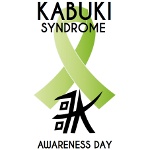Kabuki Syndrome Awareness Day Date in the current year: October 23, 2026
 Kabuki Syndrome Awareness Day is an annual observance held on October 23. It is dedicated to a rare and insufficiently studied congenital disorder that affects multiple parts of the body.
Kabuki Syndrome Awareness Day is an annual observance held on October 23. It is dedicated to a rare and insufficiently studied congenital disorder that affects multiple parts of the body.Kabuki syndrome was discovered by Japanese physician and geneticist Norio Niikawa. Dr Niikawa first observed unique facial characteristics and health problems that are now associated with the syndrome in 1969, while a treating a child patient. He assumed that he was faced with an undiagnosed genetic disorder. Kabuki syndrome (also known as Niikawa-Kuroki syndrome or Kabuki make-up syndrome) was officially discovered in 1981.
Dr Niikawa coined the term “Kabuki syndrome” as a reference to a classical Japanese dance-drama known for the elaborate make-up worn by some performers; many patients diagnosed with the syndrome have elongated lower eyelids that remind of traditional Kabuki theatre makeup.
Other symptoms include typical facial features (arched and broad eyebrows, flat nasal tip, large ears), growth delays, skeletal anomalies, low muscle tone, visual and/or hearing impairments, mild to moderate intellectual impairment, autistic-like behaviors, and others. Usually, only some of the symptoms are present in a patient with Kabuki syndrome because the disease affects each individual differently.
The syndrome doesn’t affect one’s lifespan, but coexisting conditions (for example, cardiac or renal issues) may shorten it. There is no specific treatment for the disorder, so treatment plans typically address specific symptoms.
Kabuki syndrome affects approximately 1 in 32,000 births. Due to its rarity, it is not screened for in routine prenatal testing. Kabuki Syndrome Awareness Day was created to spread information about this rare disorder and to support individuals and families affected by Kabuki syndrome.
- Category
- International Observances
- Tags
- Kabuki Syndrome Awareness Day, international awareness day, congenital disorder, Kabuki syndrome, Norio Niikawa